What are ND Filters and How are They Used?
It’s easy to spot the difference between a casual photographer and one who has made photography a way of life. While a casual photographer can make do with the lens kit that comes with their DSLR camera, a professional photographer likely has an array of different-sized lenses, lighting accessories, and image stabilizers.
In recent years, camera drones have been catching up to this trend of augmenting your photography capabilities with the right set of accessories. One of the often mentioned but rarely understood of these accessories are ND filters. What are these ND filters and how do they work? What type of ND filter should you get for your camera drone?
What are ND filters anyway and why would you need them?
Except for a few high-end (and super expensive) models, the cameras that come with drones have fixed apertures. You can think of an aperture as a hole that can shrink or expand to control how much light reaches the sensor of your camera. In DSLR cameras, aperture adjustment is just one of the many ways that a photographer can control the level of exposure of a shot. For a drone photographer, the lack of this feature means that only the ISO settings and the shutter speed can be tweaked to avoid overexposed shots.
Unfortunately, there are times when even the best combination of ISO and shutter speed settings cannot give you a good shot. ISO settings have a limited range, and even at the lowest setting, shots taken with harsh lighting can come out overexposed. While it’s possible to increase your shutter speed settings to avoid overexposed shots, this tends to result in photos that look flat and that lack the dynamic appeal of long exposure. Even videos taken at high shutter speed come out problematic with some shakiness and jello effect.
A neutral density (ND) filter is an accessory for your drone camera that effectively reduces the amount of light that enters the camera’s sensor. There are different grades of ND filters, and choosing which one works for you depends on the shutter speed you want to use and the lighting conditions. ND filters typically come in sets with each piece having a fixed number that represents how many “stops” it uses to control light. There are also variable ND filters that can be adjusted to the number of stops you want. Polarizing variants of ND filters are also available, which can reduce glare and reflected light.
How do they work?
An ND filter is essentially a piece of optical-grade glass treated with a very neutral gray dye. By adding layers of this gray dye, an ND filter can be made that reduces light with a greater number of stops. The final product is then polished, cut, and assembled into individual frames.
Although fixed ND filters are the most common, there are also those who prefer to use variable ND filters. A variable ND filter is only a single piece of filter that has an outer ring that can be rotated to control how many stops you want the lens to filter the incoming light. Some drone photographers prefer the convenience of having to bring along just one ND filter for a variety of filtration options, but the image quality of a shot captured using a variable ND filter tends to suffer as you approach the maximum ND setting.
On the other hand, there are also ND filters with polarizing features. A polarizer uses a series of wave-retarding plates to restrict the entry of light to only one axis. This ensures that only the light coming from the subject of the photo is being emphasized by removing the glare effect due to reflected light. By using a narrower focus on the subject, photos also typically come out with better color intensity.
What are the benefits of using an ND filter?
1. Take photos in harsh lighting
As we’ve mentioned, taking photos in very brightly lit areas can be problematic even at the lowest ISO settings. Even if you do manage to get a clear shot, having too much light in your photo tends to dull down the colors of your subject. Drone photography is particularly apt for ND filters since most photography has to be done during daytime, lest you run afoul of the Part 107 rules on commercial drone flight.
As an extreme example, an ND filter is a necessity in solar photography or when taking photos of a solar eclipse. Sunset photos can appear dull and lifeless when shooting without an ND filter. Landscape photographers can also benefit from the richer colors produced when ND filters tone down the effect of harsh lighting.
2. Take long exposure photos
By far, the most common use of ND filters is for long exposure photography. You’ve probably seen them before – photos of cars, waterfalls, beaches, all distinguished by a characteristic motion blur. By creating some motion blur, you give your photos a more dynamic, life-like visual appeal. It’s a neat little photography trick but setting your shutter speed very slow tends to result in overexposed photos.
The effect of an ND filter in your flexibility on setting shutter speeds is huge. For instance, you might have to take a photo of a busy freeway in the middle of the day with a shutter speed of 1/200 seconds. With an ND filter, you can reduce the shutter speed to 1/12.5 seconds with the same aperture and ISO settings to capture the same photo with motion blur. Knowing which ND filter to use for each situation is a complex matter, and it will likely take a lot of practice before you can get it right.
3. Reduce glare
Most ND filter sets some with a circular polarizer variety that is designed to reduce glare and reflections. These are particularly useful when shooting around reflective surfaces such as bodies of water. Even casual photographers have probably experienced how glare can render photos practically unusable.
What are the best ND filters available today?
ND filters essentially just clip on to your existing camera and gimbal setup. Since these setups are pretty unique, there should be an ND filter set that was made for the particular drone you are using. Aside from compatibility during installation, ND filters also designed with the gimbal’s center of gravity so that the gimbal does not end up drifting off calibration.
If you have photography experience, then you might think that there are as many ND filters for drone cameras as there are for DSLR cameras. This is not the case. ND filters for drones are a much simpler matter. Since drones have no aperture control and are not designed to take photos of close-up objects, there isn’t really a need for ND filters that allow for large aperture settings.
Below are some of the most popular ND filter sets from a couple of reputable manufacturers. These brands have years of experience creating accessories not just for drone cameras, but also for DSLR and action cameras. If you’re looking for high-quality ND filters, then you can’t go wrong with any of these:
1. PolarPro Vivid Collection 3-Pack for DJI Mavic Pro and Mavic Pro Platinum
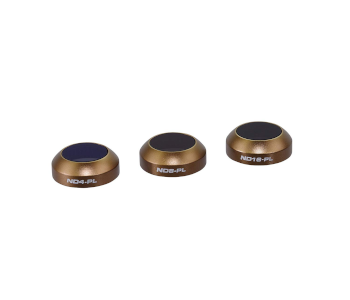
This three-pack should have just everything you need to capture great photos with your Mavic Pro and Mavic Pro Platinum. The lenses (ND4, ND8, and ND16) all have polarizer features, making them much more versatile. These are engineered precisely for the gimbal setup of the Mavic Pro and Mavic Pro Platinum. PolarPro’s signature AirFrame construction makes each ND filter extremely light so that it should not adversely affect gimbal control.
PolarPro is also very proud of their use of Cinema Series glass which has a perfectly flat surface for perfect optics. Each lens is housed in an aircraft aluminum frame with a bronze finish which does not detract from the superior aesthetics of the Mavic drones.
The lenses work flawlessly. They are easy to remove and install but are not loose at all when properly engaged. The lenses are light enough so you can attach them even before the gimbal does its initial calibration. They are a little on the expensive side as far as ND filters come, but you really get what you pay for with this product.
2. PolarPro Filter 6-Pack for DJI Mavic 2 Pro
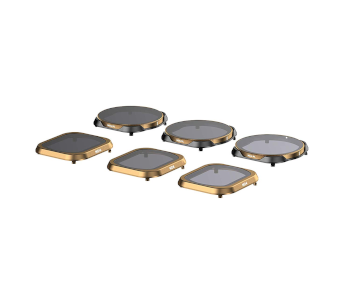
The DJI Mavic 2 Pro, in itself, is considered one of the best camera drones available today. However, it still cannot handle harsh lighting. Fortunately, PolarPro has come out with the ND filter six-pack (ND4, ND8, ND16, ND4/PL, ND8/PL, ND16/PL) especially made for the DJI Mavic 2 Pro. The six-pack contains three filtration options and three polarizers.
The features of this six-pack are really something else, as it combines the technology of both the Vivid and Shutter collections of PolarPro. Each lens has a perfectly flat optical coating with a low refractive index which ensures perfect target transmission and color neutrality. Each lens also has a waterproof, oil-proof, and scratch-resistant coating that makes them very durable and easy to care for.
3. Neewer 4-Piece ND Filter Kit for DJI Mavic Pro
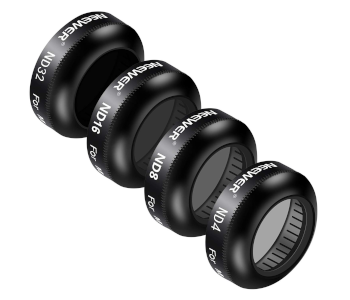
The four-piece (ND4, ND8, ND16, ND32) from Neewer is a much more affordable option for your Mavic Pro that does not compromise on quality. Although these ND filters do not have polarizers, they still open up a whole world of drone photography opportunities. Each filter is made with multi-coated optical glass with an aluminum alloy frame that delivers on excellent optical properties and durability.
At only 1.42 grams, having a Neewer ND filter installed on your camera should not cause any gimbal problems. The installation is a bit tricky, though, as you’ll need to really snap them snugly in place so that the gimbal will not report an error. Once you get them on and they pass the gimbal initialization, you should be golden.
The Neewer ND filters are a great introductory set as they don’t cost as much as the higher-end models. There are very few issues with the installation which may test your patience, but they aren’t so bad that they ruin the overall experience with the product.
4. Fstop Labs Mavic Air 6-Pack ND Filter Set
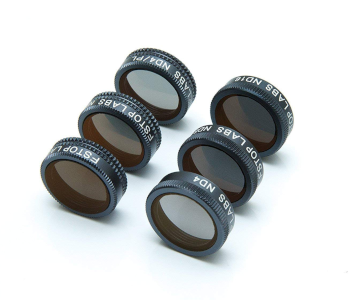
Another budget option is this six-pack (ND4, ND8, ND16, ND4/CPL, ND8/CPL, ND16/CPL) ND filter set for the DJI Mavic Air from Fstop. Despite the modest price, this pack contains three polarizing lenses.
Each ND filter is light enough to be installed before gimbal stabilization without resulting in any errors. While the optic design is impeccable, Fstop has gone the extra mile by coating with a hydrophobic layer that protects it from fogging, fingerprints, water, and dust. Each lens is protected by an aircraft-grade 6061 aluminum which is both lightweight and very strong.
Instead of snapping on, these ND filters screw on to the Mavic Air’s camera so they should remain firmly in place during flight. Installation and removal of the filters are so smooth that you might even think that DJI made them. The quality of the photos and videos that come out with the Fstop ND filters are good enough to be put side by side with more expensive ND filters, such as those from PolarPro.
In terms of value for money, this six-pack ND filter set from Fstop is hard to beat. Not only does the pack include polarizing filters on top of standard ND filters, but the design and performance are of the filters are near-perfect. This is a great buy for beginners and professionals alike.
Choosing which ND filter to use
One of the trickiest parts of using ND filters is selecting which filter to use for each situation. Without any background on using ND filter, this process could feel a bit frustrating. Let us help you out with our handy little guide below:
| Filter | F-Stop | Shutter speed | Best for |
|---|---|---|---|
| ND4 | 2 | 1/250 | Dawn or dusk |
| ND8 | 3 | 1/500 | Cloudy weather |
| ND16 | 4 | 1/1000 | Partly cloudy or sunny |
| ND32 | 5 | 1/1250 | Very bright and sunny conditions |
| ND62 | 6 | – | Extremely bright conditions such as during mid-day; when shooting in snow, water, or in a desert |
As you can see, you need to move up the number of stops when shooting in progressively brighter conditions. In terms of flexibility, the ND4 or ND8 filters are some of the most versatile ones that you can use across different circumstances. In fact, some drone photographers have taken to using these filters permanently and changing them out only when necessary.
If you don’t want to have to look at some table every time you go out to snap photos with your drone, then there is also a more modern solution. PolarPro has developed a mobile app that you can use to pick which ND filter to use depending on the weather, the time of day, and the shutter speed settings you want to use. The app also tells you if the golden hour is coming up so you can position your drone just in time to capture the perfect sunset lighting. Best of all, the app is free. If you’ve decided on using an ND filter set, then this app could be a valuable addition to your photography arsenal.
Final thoughts
A lot of drone photographers say that the use of ND filters is what separates the amateurs from the professionals. It’s a bit of a conceited thing to say, but it’s not far from the truth. For many drone photographers, the day they bought a set of ND filters changed how they viewed drone photography and its many possibilities.
ND filters do open up a whole new world of photography opportunities. Shots come out with richer colors and with a more dynamic and alive feel that is just not possible with a stock camera kit. If you’ve already invested in a high-quality camera drone, why not expand those horizons with an ND filter kit? They are cheap, versatile, and extremely useful. Go get a couple of ND filters – you will certainly not regret it.

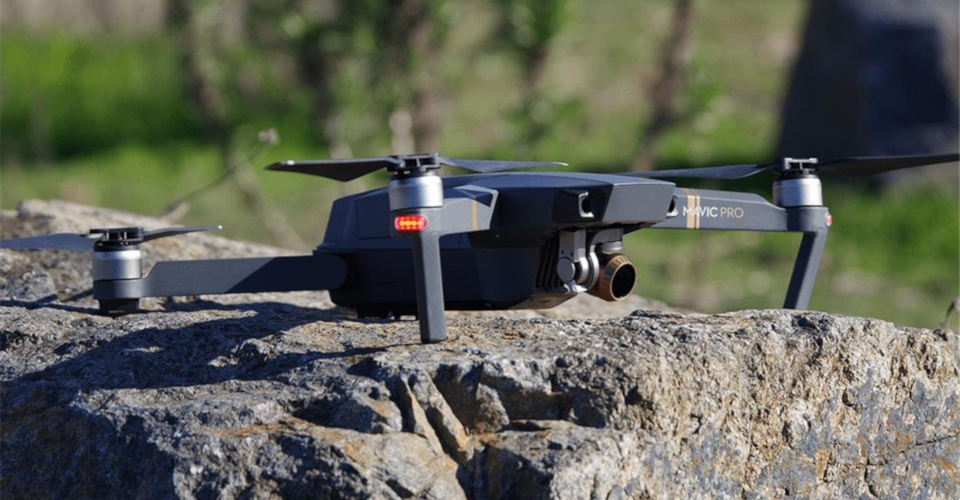

Really good site,thank so much for your effort in writing the posts.